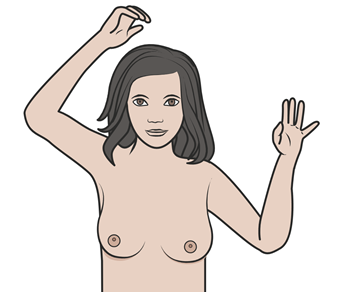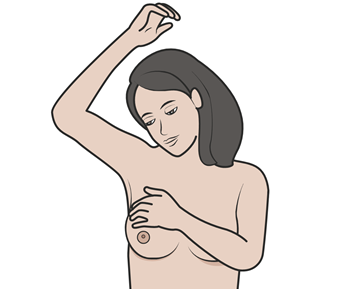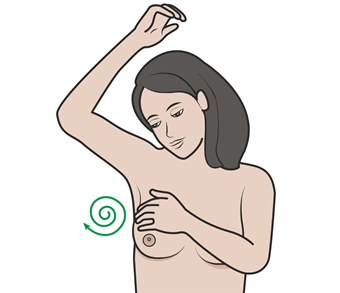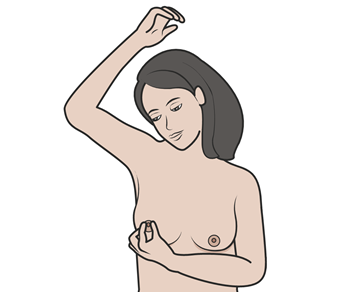Breast self-evaluation (BSE): A means of early breast cancer detection
Published 20 Dec 2021 • By Claudia Lima
Breast cancer is the most common and deadliest cancer in women. 1 in 8 women is likely to develop it in her lifetime. However, the mortality rate is decreasing year by year, thanks to improved treatments, but also thanks to breast cancer screening that is increasingly adapted to each woman's risk level.
One of the ways to detect this disease at an early stage is through self-examination.
But how to go about a breast self-exam? When should it be done?
We explain it all in our article!

Breast cancer is caused by a disruption in cells that multiply and form a mass called a tumour. The tumour affects the mammary gland and can spread to other parts of the body, provoking metastases.
It is essential for every woman to look for any changes in her breasts and to get screened regularly.
A clinical breast examination (palpation) by a health professional is recommended every year starting from the age of 20. Then, if there are no symptoms or risk factors for developing breast cancer, NHS recommends breast screening (mammogram) every 3 years for women aged 50 to 71.
For women with a medical and family history or genetic predispositions, there are specific follow-up procedures.
If you notice a change in the breasts, you should see a doctor as soon as possible. It can be a lump or a swelling in the breast or in the armpit, or a change in skin texture. All of these can be the first signs of breast cancer.
In the UK, breast cancer is responsible for the death of more than 11,000 women every year. 8 out of 10 cases are diagnosed in women over 50 years old. If detected early, breast cancer has a good prognosis with a survival rate of approximately 85%.
This is why doctors strongly encourage all women to regularly perform breast self-examination. It can also be a supplement to examinations carried out as part of breast cancer screening programme.
In fact, early detection allows less aggressive and more conservative therapeutic care plan for people with malignant tumours, an early diagnosis has therefore a major impact on breast cancer treatment.
Breast self-examination, what is it?
Breast self-examination, or self-check, includes special gestures that allow a woman to detect any possible abnormalities in her breasts. It is a painless examination that consists of feeling the breast and the area under the armpit to look for any unusual lumps or redness, and therefore tumours.
This self-exam makes it easy to notice any changes in the breast, and then report it to your doctor.
Breast prostheses do not prevent women from breast self-examination.
What are the gestures and when to do them?
Breast self-exam is divided into two parts. The first one is a visual observation phase, the second one is a palpation phase.
Here is how you should proceed:
- Uncover your breasts and stand in front of the mirror:
- Visually inspect both breasts, paying attention to the following: nipple discharge, cracked, dimpling, puckering or peeling skin, the shape of the breasts
- Raise the right arm and put the three fingers of the left hand together as in the image below:



- Examine your breast using the three fingers. Palpate the entire right breast firmly and carefully. Starting with the outer part, move your fingertips across your breast in small circles, or in lines. You should pay particular attention to the armpit and the area between the armpit and the breast,
- Examine your nipple. Gently pinch it to check for any signs of fluid coming out of it, or any other abnormality,

- Repeat all the actions for the left breast

Source: Sante.bd, self-examination, how to do a breast self-exam
Some specialists recommend self-examination at least once a month, on the same day, a few days after your period, when the tissues are softer, starting when you are in your twenties. It is recommended to carry out this examination always at the same period of time so that the comparison is relevant.
If you are going through menopause, check your breasts on the same day each month.
What should you do if you find something unusual?
You may find some abnormalities during a breast self-examination. These can be: suspicious lumps, skin puckering, the appearance of a small crack or sores, blood or fluid coming out from the nipple, etc.
If you notice any of these signs, you should see a GP or a gynecologist as soon as possible. They will perform a breast palpation and, if necessary, prescribe additional examinations (blood tests, ultrasound, MRI, mammogram, etc.).
Contrary to the popular belief about cancer and breast self-examination, the appearance of lumps or other changes in the breast does not necessarily indicate the presence of a tumour or breast cancer. It can actually be a benign condition. However, it is still recommended to have any abnormalities checked by a healthcare professional.
Self-examination of the breasts is not a substitute for regular visits to a GP or o gynecologist.
According to Cancer Research Institute, early detection leads to a 98% survival rate (five years and more).
Was this article helpful to you?
Give it a like and share your thoughts and questions with the community in the comments below!
Take care!
Sources:
Dépistage du cancer du sein, se faire dépister, e-cancer.fr
Le cancer du sein, les cancers les plus fréquents, e-cancer.fr
Cancer du sein.org, l'auto-examen des seins, cancerdusein.org
Comment se palper les seins, sante.journaldesfemmes.fr
L'autopalpation, je me fais un examen des seins, santebd.org
L'autopalpation des seins, parlons-en, mon-cancer.com
Autopalpation des seins, apprendre à détecter une masse suspecte, ishh.fr


 Facebook
Facebook Twitter
Twitter


